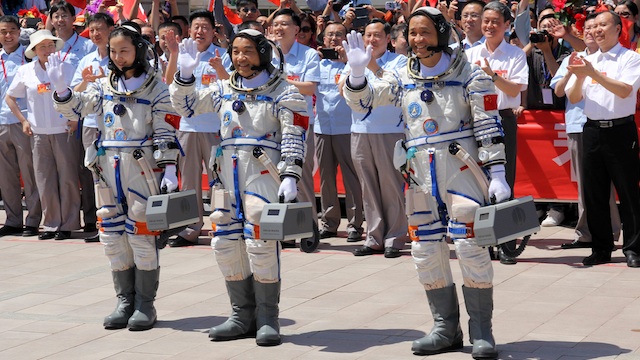SUMMARY
This is AI generated summarization, which may have errors. For context, always refer to the full article.

BEIJING, China – China completed its longest manned space mission Wednesday, June 26, as its Shenzhou-10 spacecraft and 3 crew members safely returned to Earth, in a major step for Beijing’s goal of building a permanent space station by 2020.
The return capsule touched down at 8:07 am (0007 GMT), live state TV footage showed, kicking up a cloud of dust on the grasslands of north China’s Inner Mongolia region.
Technicians quickly gathered to open the craft’s hatch and crawled inside to check the crew’s safety. Applause erupted at China’s mission control centre when word came they were in good condition.
A smiling mission commander Nie Haisheng was the first to emerge from the capsule at 9:31 am. He was led to a chair and sat down nearby to wait for his fellow crew members to come out.
He was followed later in succession by female astronaut Wang Yaping, who also smiled and waved, and Zhang Xiaoguang.
The 15-day Shenzhou-10 (“Divine Vessel”) mission is seen as another step in Beijing’s ambitious objective of building a space station.
Highlights of the mission included dockings with China’s orbiting space module Tiangong-1 in tests intended to prepare for the building of the country’s own space station.
Wang delivered a video class to children across the country from space last week, showing how a variety of objects — from a bubble of water to a spinning toy — behave in zero gravity. The crew also conducted medical experiments during the mission.
China first sent a human into space only in 2003 and its capabilities still lag behind the US and Russia. But its program is highly ambitious and includes plans to land a man on the moon.
Beijing sees its multi-billion-dollar space program as a symbol of its rising global stature, growing technical expertise, and the Communist Party’s success in turning around the fortunes of the once poverty-stricken nation.
The space program is heavily promoted on Chinese media. On Monday, President Xi Jinping, who had travelled to the Jiuquan space centre in the Gobi desert to witness the blast-off on June 11, spoke to the crew via video call.
“The space dream is part of the dream to make China stronger,” Xi told them, the state Xinhua news agency reported, referencing his signature “Chinese dream” concept.
“With the development of space programs, the Chinese people will take bigger strides to explore further into the space,” he said from the Beijing Aerospace Control Center. – Rappler.com
Add a comment
How does this make you feel?
There are no comments yet. Add your comment to start the conversation.